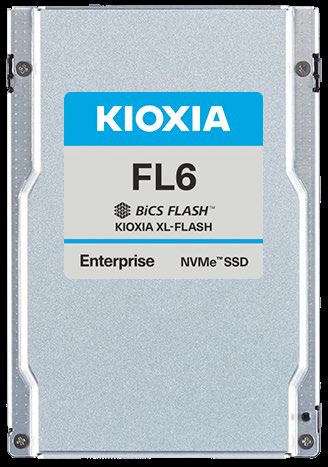A rather interesting entry into the SSD world by KIOXIA as of late has many businesses watching closely. The KIOXIA FL6 enters the same space as both the Samsung Z-NAND and Intel Optane SSDs and many believe the KIOXIA entry may make quite the impression with respect to comparable pricing. Rather unique is the fact that the FL6 is KIOXIA’s newest XL-flash which is their current BiCS flash being used in SLC mode. For those old enough to remember the introduction of SLC SSDs to the consumer/enterprise space way back in 2008, SLC memory contains only 1-bit per cell which speaks to much higher endurance as well as higher performance at a much lower latency. The key here is low latency.
The KIOXIA FL6 contains a native dual port PCIe 4.0 interface and uses the latest NVMe 1.4 protocol. It will be available in capacities of 800GB to 3.2TB, speaks to a massive 60 DWPD (Drive Writes per Day) endurance, has SED and FIPOA 140-2 certification and is NVMe over Fabric ready.
KIOXIA describes the FL6 as being a new layer in the storage architecture between TLC NAND SSDs and DRAM. XL-flash is described as 128Gb die in a 2,4 or 8-die package in a 16 plane design for improved latency. Make no mistake, one is not finding this on the consumer shelf as it is created for enterprise or data center use and very high data read demands.
Last but not least performance and we have to credit blocksandfiles.com who states that they obtained this through KIOXIA, although no other seems to have had the same success. This speaks to a 2.5″ U.3 design which uses the same SFF-8639 connector used in U.2 SSDs, but combines SAS, SATA and NVMe support into a single controller.
Our interest in these type of low latency SSDs actually lies outside the enterprise/data center space, as was shown in our report on the Intel P5800x. Like the P5800x, the FL6 is a storage class memory product (SCM) which moves the performance features of DRAM and flash into that of persistent memory, both seated on the memory bus.
Simply put, we get tons of interest in the professional media space. We can see that specs fall just below that of the Intel offering but who knows, pricing may make a huge impact in this case. Let’s wait and see!
 The SSD Review The Worlds Dedicated SSD Education and Review Resource |
The SSD Review The Worlds Dedicated SSD Education and Review Resource | 

